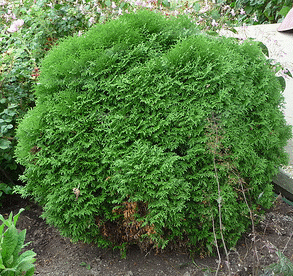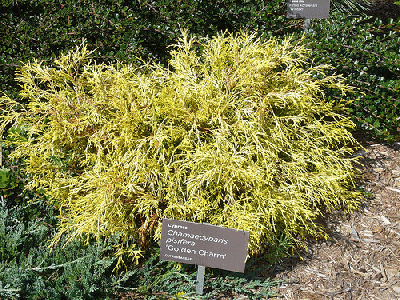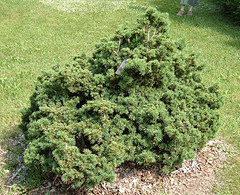Medium Evergreen Shrubs
Medium evergreen shrubs are about 4 to 6 feet high
NOTE: Retailers often list size of a ten year old plant. Since many evergreens live 35-50 years plants will usually exceed their listed size
Granular fertilizer is recommended for evergreens since it releases slowly into the soil, benefiting your plant for 1 to 3 months. Care must be taken not to sprinkle the fertilizer on the foliage. Sprinkle directly onto the soil around and under the plant. If it is not possible to avoid the foliage, a liquid fertilizer may be a better choice. Liquid fertilizer is faster acting and available to your plant for 2 - 4 weeks.
Thuja occidentalis ‘Little Giant’ Arborvitae
Conifer Family: Cupressaceae
Mature Height: 4-6 feet
Mature Width: 4-6 feet
Growth Rate: Slow
Light Requirements: Full sun to part shade
Water Requirements: Require weekly watering, tolerates wet soil.
Soil Preference: Average well drained soil, very adaptable.
Foliage: Emerald green flat sprays, soft foliage.
Cone or Berry: Tiny inconspicuous green cones.
Disease and Insects: No notable problems. Resists mites, bagworms and canker.
Pest Resistance: Deer enjoy arborvitae.
Fertilize: Use a 6-12-12 or 10-10-10 fertilizer in early spring
Spacing: Plant 7 or more feet apart, 3-4 feet apart for a hedge.
Hardiness: Zones 2-7
‘Little Giant’ is an easy to grow and care for evergreen with a nicely rounded dense shape that does not require pruning to keep a globe form. It is widely used because it is very adaptable and tough. Shears well to maintain a smaller size or to maintain a more formal shape, but only shear to new growth as the foliage will not recover if hard pruned. Creates a lovely hedge when left unsheared, or pruned to geometric shape. Excellent for foundation plants or shrub borders. (‘Hetz Midget’ is one of the smallest globular evergreens available for landscape plantings. In ten years it will grow to about 3-4 feet tall and wide.) May damage in strong winds, especially cold winds of the north as well as winter sunscald. But the damaged foliage shears off easily without detriment to the shrub. Heavy wet snow may bend and break branches, these may be pruned out and the shrub should fill back in fairly quickly. In ideal conditions ‘Little Giant’ can be expected to live 30 years.
Chamaecyparis pisifera filifera ‘Golden Charm’ Golden Charm Thread Branch Cypress
Conifer Family: Cupressaceae
Mature Height: 4-7 feet
Mature Width: 6-8 feet
Growth Rate: Slow
Light Requirements: Full sun to part shade.
Water Requirements: Needs weekly watering, more in periods of extreme heat.
Soil Preference: Average moist soil, prefers acidic soil.
Foliage: Yellow green feathery foliage
Cone or Berry:
Disease and Insects: No significant problems.
Pest Resistance: Deer resistant
Fertilize: Use a 6-12-12 or 10-10-10 fertilizer in early spring
Spacing: Plant 7 or more feet apart.
Hardiness: Zones 4-8
‘Golden Charm’ has a mounded shape early, but matures to a more erect conical shape. Foliage is thread like and weeping, creating a mop head like appearance. And yet the fine delicate foliage has an elegant look. This evergreen holds a bright golden color even in full sun. ‘Golden Charm’ is very tolerant of urban conditions and pollution. Excellent evergreen for back of the perennial border, accent plant or feature plant, or hedge. May be sheared in fall if a neater appearance is desired, but do not remove more than the current seasons growth.
Picea pungens ‘Globosa’ Dwarf Globe Blue Spruce
Conifer Family: Pinaceae
Mature Height: 3-5 feet
Mature Width: 5-6 feet
Growth Rate: Slow to moderate
Light Requirements: Part to full sun
Water Requirements: Requires weekly watering, more in extreme heat. Will tolerate short drought periods.
Soil Preference: Average well drained soils, but prefers fertile slightly acidic soil.
Foliage: Light blue prickly short needles, 3/4” long. New growth emerges silvery blue.
Cone or Berry: Rarely produces cones.
Disease and Insects: No significant problems.
Pest Resistance: Deer Resistant
Fertilize: Use a 6-12-12 or 10-10-10 fertilizer in early spring
Spacing: Plant 6 or more feet apart.
Hardiness: Zones 2-8
‘Globosa’ Blue Spruce is a dwarf flat topped globular evergreen shrub with dense branches. The bright blue foliage color holds all year and is a bit brighter in summer. The dense rounded form bright blue coloring is ideal for Asian gardens, accent or specimen plant, give contrast to green evergreens or cool hot colors in a perennial border. ‘Globosa’ Blue Spruce can be expected to live 60 years in ideal conditions, and can eventually reach a size of at least 8 feet tall and 6 feet wide. In poor conditions it could remain as small as 3 feet tall and 4 feet wide in 10 years or more. Keep in mind that this is a “dwarf” of a huge spruce. It does not do well in heat and humidity, preferring the cooler climates. The form may become slightly upright and conical if a central leader is formed. To retain the globular shape, prune off the central leader as soon as it forms. To control size, prune off the tips every year. Also available as a standard and is a nice way to elevate the dense rounded form.
The cultivar name ‘glauca’ and the term dwarf for spruce are a loose reference to the term dwarf, so caution when selecting a cultivar is advised. Named cultivars may have more consistent and reliable characteristics, for example: ‘Glauca Compacta’, Glauca Globosa’, ‘Hunnewelliana’ and ‘R.H. Montgomery’ are impossible to tell apart when young but may have slightly different characteristics and mature sizes. They all tend to reach maturity far faster than a true dwarf would be expected, so the term ‘Compacta’ is more appropriate than dwarf. ‘R.H. Montgomery’ will likely develop to a conical form and grows as much as 9 inches per year. And a true ‘Glauca Globosa’ can even reach 30 to 35 feet tall at 60 years. To try to add some clarity, it is more than likely that any dwarf blue spruce globe available is ‘Glauca Globosa’ or ‘R.H. Montgomery’ and botanists are unable to determine any distinguishable difference. Since the growers use such generic names for their plants, it is difficult for even a reliable nursery to present accurate information, but do question them if size will be critical.
Juniperus chinensis / Juniperus x pfitzeriana ‘Saybrook Gold’
Conifer Family: Cupressaceae
Mature Height: 4-6 feet
Mature Width: 6-8 feet
Growth Rate: Moderate, 4-8” per year
Light Requirements: Full sun
Water Requirements: Average water requirements, drought tolerant once established.
Soil Preference: Average well drained soil, prefers sandy and neutral to acidic. Adaptable to most conditions except wet.
Foliage: Golden yellow foliage with a feathery appearance. New growth is soft, matured needles become prickly.
Cone or Berry:
Disease and Insects: No notable problems. Can be susceptible to blight in cool wet weather.
Pest Resistance: Deer resistant
Fertilize: Use a 6-12-12 or 10-10-10 fertilizer in early spring
Spacing: Plant 9 or more feet apart, 4-5 feet apart for groundcover.
Hardiness: Zones 4-9
‘Saybrook Gold’ is an excellent specimen for large spaces in your landscape or for bushy groundcover. Spreading, arching branches droop slightly at the tips and should not be pruned to maintain the form. Remove entire branches to the base or at a joint to control size if necessary. Bright gold foliage adds colorful contrast to deep green and blue evergreens, and holds good gold color throughout the year. Foliage turns bronzed yellow in winter. In ten years ‘Saybrook Gold’ will be about 2-3 feet high and 5-6 feet wide.
Picea abies ‘Nana’ Dwarf Norway Spruce
Conifer Family: Pinaceae
Mature Height: 5 feet
Mature Width: 6 feet
Growth Rate: Slow
Light Requirements: Full sun to part shade.
Water Requirements: Average water requirements, preferring evenly moist conditions. Adaptable but will not tolerate standing water.
Soil Preference: Average well drained soil, very adaptable. Not fussy about pH and will tolerate salt.
Foliage: Needles emerge light green in spring and mature to blue green.
Cone or Berry:
Disease and Insects: No notable problems.
Pest Resistance: Deer resistant.
Fertilize: Use a 6-12-12 or 10-10-10 fertilizer in early spring
Spacing: Plant 6 or more feet apart.
Hardiness: Zones 3-7
Dwarf Norway Spruce is termed dwarf only relative to the huge size of the Norway Spruce species. This large “dwarf” is a lovely densely mounded evergreen shrub, forming a globular shape that is wider than tall. Foliage emerges light green in spring and matures to blue green. It will do well in either full sun or part shade, it will prefer the morning sun to afternoon. Once established Picea abies ‘Nana’ is a very tolerant evergreen in urban conditions, saline soil, poor soil and dry conditions. Pruning is generally not necessary. To control size or shape only prune off new growth. Good specimen plant or to anchor a perennial planting. Excellent foundation shrub where space allows. In ten years it will reach about 2-3 feet high and wide. Under ideal conditions Dwarf Norway Spruce can be expected to live 50 years or more.
Thuja occidentalis ‘Rheingold’ Rheingold Arborvitae
Conifer Family: Cupressaceae
Mature Height: 3-5 feet
Mature Width: 3-5 feet
Growth Rate: Slow to moderate, 6-12” per year.
Light Requirements: Full sun to part shade.
Water Requirements: Requires weekly watering, more often in extreme heat. Will not tolerate dry soil. As the plant is better established and matures it will tolerate dry periods.
Soil Preference: Prefers organically enriched, moist well drained soil. Will do fine in average soil.
Foliage: Bright golden flat fan shaped sprays.
Cone or Berry:
Disease and Insects: No notable problems.
Pest Resistance:
Fertilize: Use a 5-10-10 fertilizer or compost in early spring.
Spacing: Plant up to 9 feet apart, closer, or much closer depending on willingness to prune.
Hardiness: Zones 2-7
‘Rheingold’ is an easy to grow low maintenance dwarf evergreen. The globular form may sometimes tend dome shaped, but shears well to maintained a more rounded shape if desired. The ever changing bright golden foliage develops to more bright green with yellow tones in summer, often orange gold tipped in fall, then bronzes in winter. Foliage grows dense in full sun, too much shade may result in loosely branched open growth, and less color interest. In hot regions, ‘Rheingold’ will benefit from afternoon shade. May be winter burned where exposed to cold winter winds, but the damage is easily sheared off in spring. Heavy wet snow may damage or break branches, damage should be pruned out. ‘Rheingold’ is very versatile and compact enough for most foundation plantings, after 10 years size may need to be controlled with shearing. Excellent as an informal hedge, or a more formal clipped hedge. Adds nice color contrast in a shrub or perennial border. Shear annually in spring if a neater appearance is desired, removing only new growth. Do not hard prune, as the foliage will not likely recover. In ten years ‘Rheingold’ will reach about 5 feet high and wide, but in time can grow as large as 10 feet high and 8 feet wide.
Tsuga canadensis ‘Beehive’ Dwarf Canadian Hemlock
Conifer Family: Pinaceae
Mature Height: 4 feet
Mature Width: 4-5 feet
Growth Rate: Slow, 3 inches per year
Light Requirements: Part Shade
Water Requirements: Frequent watering is required, preferring evenly moist but well drained soil
Soil Preference: Organically rich, neutral to acidic pH preferred, tolerates alkaline soil
Foliage: Feathery light green with slightly drooping branches
Cone or Berry: Tiny 1/2” cones start green and become brown in the second year
Disease and Insects:
Pest Resistance: Deer resistant
Fertilize: Use a 5-10-10 fertilizer or compost in early spring.
Spacing: Plant 4-6 feet apart
Hardiness: Zones 4-7
‘Beehive’ forms a very broad dome shape that resembles a spreading beehive. The feathery texture and light, but bright green foliage add unique shape and texture to a border garden or foundation planting. This dwarf prefers afternoon shade, Four to six hours of morning sun is ideal. Canadian Hemlock can be a little fussy and do not generally tolerate poor or wet soil, long periods of heat or drought, wind, pollution or salt spray. Keep the shallow roots moist and cool by mulching. Be sure to water regularly in the first year or two of growth until the plant is well established. In ideal conditions ‘Beehive’ can grow as large as 8 feet wide, but since it tends to be a bit fussy this may not be likely. ‘Beehive’ has been known to do well in zone 3 also.
Chamaecyparis pisifera ‘Mops’
Conifer Family: Cupressaceae
Mature Height: 5 feet
Mature Width: 7 feet
Growth Rate: Slow, 3-6” per year
Light Requirements: Full sun, afternoon shade in hot regions.
Water Requirements: Needs weekly watering, more often in extreme heat. Will become more drought resistant as it matures.
Soil Preference: Average to fertile well drained soil, does not like wet soil.
Foliage: Yellow green threadlike foliage
Cone or Berry: Inconspicuous
Disease and Insects: No significant pest problems
Pest Resistance: Deer resistant
Fertilize: Use a 6-12-12 or 10-10-10 fertilizer in early spring
Spacing: Plant 7-10 feet apart.
Hardiness: Zones 4-8
The dramatic foliage of the ‘Mops’ is bright yellow green to golden with a feathery, almost stringy appearance. The slightly weeping branches gives the plant a shaggy, mophead form. The glowing gold foliage creates a lovely accent to deeper green conifers. Color is best in full sun, but will do fine in part shade. The striking golden color of ‘Mops’ holds well through the year when planted in full sun, unlike the ‘Filifera Aurea Nana’, which will fade by mid summer. But when planted in a cool climate where ‘Mops’ can handle the full sun, you may want to protect from winter burn. At maturity, ‘Mops’ will not likely be completely covered by snow for protection. ‘Mops grows in a mounding form, but if a neater form is desired, shear annually to shape it. To control size, prune out branches to a joint to retain the unique shape. In ideal conditions ‘Mops’ can grow larger. Regular watering is important, especially in the first season to establish a good root system. Under ideal conditions, ‘Mops’ can be expected to live 50 years. May also be known as ‘Gold Mop’ or ‘Golden Mops’, but the names are used too generically, so be cautious and be sure you are purchasing the size plant you want. Cultivars of ‘Mops’ can vary dramatically in size, and you will find that ‘Mops’ is identical to the dwarf ‘Golden Mop’ other than the size.. (See the article on ‘Mops’ confusion)







